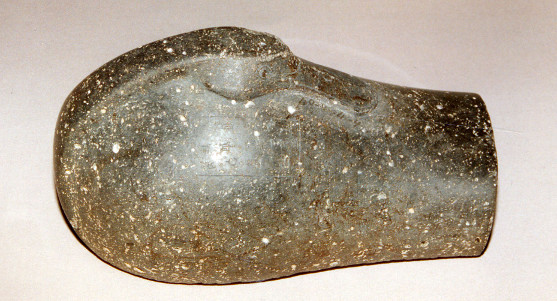Inscriptions

BM 091433 © The Trustees of the British Museum
This short inscription is written on a duck weight made of a green
stone (syenite or basalt), measuring around 32 cm long and weighing
about 15 kilograms. The weight, now in the British Museum, was found
by Sir Austen Henry Layard in the Northwest Palace at Nimrud, where it
was probably brought as booty by an Assyrian ruler after an incursion
into Babylonia, as for Nabû-šumu-libūr
1 [/ribo/babylon2/Rulers/Nabu-shumu-libur/index.html].
The Akkadian inscription records the value of the weight, consisting in thirty
minas, and the belonging of the object to the Palace of Erība-Marduk, presented as "king of Babylon."
Access the composite text [/ribo/babylon6/Q006300] of Erība-Marduk 1.
Source
Bibliography
- Norris 1856, pp. 217-218 (translation)
- Brandis 1866, p. 46 (translation)
- Smith 1872, p. 75 no. 59 (translation)
- Ménant 1875, p. 130 (translation)
- Smith 1875, p. 91 no. 57 (translation)
- Winckler 1889, p. 32 (edition)
- Weißbach 1907, p. 395 no. 7 (translation)
- Weidner 1915, p. 103 (translation)
- BM Guide 1922, p. 213 no. 253 (translation)
- Weißbach 1938, pp. 463-464 (translation)
- Frame 1995, p. 115 (edition)
- Layard 1853, pp. 600-601 (copy in type)
- Norris 1856, pl. facing p. 222 no. 1 (copy in type)
- Pritchard 1969, no. 120 (photo)
- Norris 1856, pp. 217-218 (study)
- Weißbach 1907, p. 395 no. 7 (study)
- BM Guide 1922, p. 213 no. 253 (study)
- Brinkman 1968, pp. 6, 223 n. 1399, and 354 no. 31.2.1 (study)
- Pritchard 1969, no. 120 (study)
This short inscription is written on a fragmentary black basalt duck weight measuring around 14 x 11 cm. The weight, now in the
Iraq Museum, was found in 1973 during the German excavation conducted at Uruk in
the area of the Gareus temple.
The short Akkadian inscription, mentioning the
belonging to Erība-Marduk, is only partially preserved but can be
restored on the basis of the Erība-Marduk 1 text.
Access the composite text [/ribo/babylon6/Q006301] of Erība-Marduk 2.
Source
Bibliography
- Wilcke 1983, p. 54 (edition)
- Becker 1993, no. 555 (edition)
- Frame 1995, pp. 115-116 (edition)
- Wilcke 1983, pl. 28f-g (photo, copy)
- Becker 1993, no. 555 (photo, copy)
- Becker 1993, no. 555 (study)
Giulia Lentini
Giulia Lentini, 'Inscriptions', RIBo, Babylon 6: The Inscriptions of the Period of the Uncertain Dynasties, The RIBo Project, a sub-project of MOCCI, 2025 [http://oracc.museum.upenn.edu/ribo/babylon6/EarlyFirstMillenniumRulers/Eriba-Marduk/Inscriptions/]